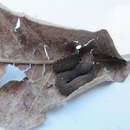en
names in breadcrumbs


Peripatus /pəˈrɪpətəs/ is a genus of velvet worms in the Peripatidae family.[1] The name "peripatus" (unitalicised and uncapitalised) is also used to refer to the Onychophora as a whole, although this group comprises many other genera besides Peripatus. The genus Peripatus is found in Central America, the Caribbean and northern South America.[1] Velvet worms in this genus can have as few as 24 or 25 pairs of legs (in P. antiguensis or P. dominicae, respectively)[2][3] or as many as 36 leg pairs (in P. evelinae).[4] This genus is viviparous, with mothers supplying nourishment to their embryos through a placenta.[5]
The genus contains the following species:[6][1]
Peripatus antiguensis Bouvier, 1899 and Peripatus bavaysi Bouvier, 1899 are considered nomina dubia by Oliveira et al. 2012.
{{cite journal}}: CS1 maint: multiple names: authors list (link) Peripatus /pəˈrɪpətəs/ is a genus of velvet worms in the Peripatidae family. The name "peripatus" (unitalicised and uncapitalised) is also used to refer to the Onychophora as a whole, although this group comprises many other genera besides Peripatus. The genus Peripatus is found in Central America, the Caribbean and northern South America. Velvet worms in this genus can have as few as 24 or 25 pairs of legs (in P. antiguensis or P. dominicae, respectively) or as many as 36 leg pairs (in P. evelinae). This genus is viviparous, with mothers supplying nourishment to their embryos through a placenta.